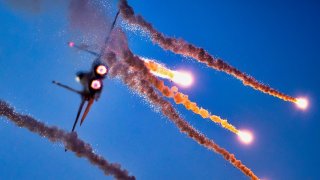How Will Israel Strike Back?
Given ongoing civil unrest in Iran, a major Israeli strike on its petroleum facilities or an attack that targets the IRGC or the Iranian leadership could result in a major public upheaval that brings down the forty-five-year-old theocratic regime.
Israel has promised to retaliate for the Iranian ballistic missile strike on its airfields and cities, which left several people injured, hit a school in Gedera, caused some damage at the Tel Nof airbase and landed at or near the Hatzerim and Nevatim airbases. The last of these houses Israeli F-35 fighter aircraft, though it is not clear whether any of them were hit. The vast majority of F-35s presumably were conducting air operations at the time. In turn, Iran’s Islamic Revolutionary Guard Corps (IRGC) has promised that should Israel retaliate for the Iranian attacks, it would unleash an even more devastating blow against the Jewish State.
It is unlikely that the IRGC’s threats will deter Jerusalem. To begin with, Israel was not alone in defending against Iran’s ballistic missiles. For the second time, not only the United States but Britain, France, and Jordan came to Israel’s defense. Amman did so to protect its own people from both wayward missiles and shrapnel. Indeed, falling shrapnel wounded two people on Jordanian territory. Israel can, therefore, expect that should Iran launch yet another strike, America will come to its defense. So, too, Jordan will once again protect its own citizens. And other states, notably Britain, may do so as well.
There can be little doubt that Israel will go on the offensive in response to the Iranian attack. One option would be for it to attack some of Iran’s nuclear facilities. It certainly has the capability to do so since it operates tanker aircraft and likely would be able to refuel over Saudi airspace.
But Iran’s nuclear facilities are buried deep underground and are widely dispersed throughout a country the size of Texas. Without American assistance, Israel could not possibly destroy all of Iran’s facilities, and that assistance is unlikely to be forthcoming. Moreover, an attack on its nuclear facilities would enable Iran both to accelerate and justify its nuclear weapons program. And it would unite the Iranian people who, despite all their other differences with the mullah regime, have tended to support that program.
Israel does have other options, however. In responding to the Iranian missile attack on its territory this past April, Israel demonstrated that it can penetrate Iranian air defenses. As long as it can refuel its fighters for long-range operations, it could attack Iran’s oil refinery at Bandar Abbas. Such an attack would constitute a devastating blow to Iran’s economy, which, thanks to its fossil fuel sales, is projected to grow by 2.7 percent this year.
Israel could also attack IRGC headquarters or even attempt to eliminate Supreme Leader Ayatollah Ali Khamenei himself. Khamenei and his associates clearly fear that Israel may be targeting them; the Supreme Leader has moved to an “undisclosed location.”
Given ongoing civil unrest in Iran, a major Israeli strike on its petroleum facilities or an attack that targets the IRGC or the Iranian leadership could result in a major public upheaval that brings down the forty-five-year-old theocratic regime. The Iranian public has been restive for years, choking under a puritanical dictatorship. The mullahs are surely aware of their vulnerability to a popular revolution, and for that reason, they may well elect not to pursue another round of tit-for-tat attacks. Instead, and in order to save face, they may decide to allow the “international community” to broker a cease-fire with the Israelis, thereby avoiding, at least for the short-term, if not longer, an all-out conflict between the two most powerful forces in the Middle East.
About the Author:
Dov S. Zakheim is Vice Chairman of the Foreign Policy Research Institute, Senior Advisor at the Center for Strategic and International Studies, and a member of The National Interest Advisory Board. He is a former Undersecretary of Defense and Deputy Undersecretary of Defense.
Image: Shutterstock.


